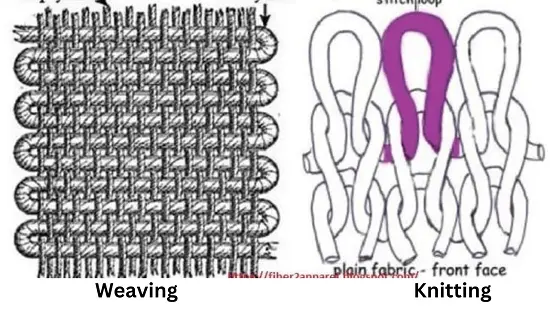Fabric is the most important and indispensable part of clothing. Do we know how many ways to make fabric? What are the types of Fabric manufacturing processes? Here we are discussing the Differences Between Weaving and Knitting; one thing is common, both are the Fabric manufacturing process. In this article, we mentioned 18 Differences Between Weaving and Knitting below.
Weaving
Interlacing two sets of threads, the warp (lengthwise) and the weft (crosswise) on a loom machine to manufacture Woven Fabric, is called weaving. Weaved fabrics often have a more structured and stable feel due to the perpendicular arrangement of the threads. Weaving allows for intricate patterns and designs due to the controlled placement of individual threads. Complex designs and geometric patterns are achievable through different weaving techniques.
Knitting
Interlocking loops of yarn using needles in a knitting machine in order to manufacture knit fabric is called the Knitting process. Knitted fabrics tend to be more stretchable and flexible than woven fabrics because the loops allow for movement. Knitting allows for varied textures, including cables, ribs, and lace, due to the flexibility in stitch patterns.

Differences Between Weaving and Knitting
It is very easy to differentiate between Weaving and Knitting, but given our best to bring all the differences in the process, Structure, Texture, Characteristics, and many many more; let’s have a look following:
| Serial | Weaving | Knitting |
| 1 | Interlacing two types of threads in the Weaving Process | Two set of connected loops from a series of yarns. |
| 2 | Weaving process produce woven Fabric | Knitting process produce Knit Fabric |
| 3 | Weaving produces a more rigid fabric. | knitting yields a stretchy and more pliable material |
| 4 | Sizing is required before weaving. | Do not require sizing in Knitting. |
| 5 | Yarn preparation is a must. | Yarn preparation is not so necessary. |
| 6 | The production capacity of weaving is less than knitting. | The production capacity of knitting is more. |
| 7 | The production cost of weaving is higher than the knitting cost. | The production cost of knitting is less than the weaving cost. |
| 8 | About 48% of fabrics are produced by weaving techniques in the textile section. | About 52% of fabrics are produced by knitting technology in the textile section. |
| 9 | Weaving is done by shade formation. | Knitting is done by loop formation. |
| 10 | The elastic property of the woven fabrics is less than knitted fabric. | The elastic property of the knit fabrics is higher than the woven fabric. |
| 11 | Mostly flat machines are used for production. | Flat and circular machines are used for production. |
| 12 | The woven fabrics are less resistant to crease, so require ironing. | Knitted fabrics are more resistant to creases, so they require no ironing. |
| 13 | It is not difficult to tear the woven fabric. | It is not easy to tear the knitted fabric. |
| 14 | The woven fabric absorbs less moisture than knitted fabric. | Due to the loose construction of knitted fabrics, they absorb more moisture than woven fabric. |
| 15 | Due to compact construction, woven fabric is less air permeable. | Due to the voluminous structure of the knitted fabric, the Knitted fabric is more air permeable. |
| 16 | Yarn TPI is comparatively higher than knitted fabric. | Yarn TPI is comparatively lower than woven fabric. |
| 17 | Dimensional stability is higher than in knitted fabric. | Dimensional stability is lower than woven fabric. |
| 18 | Examples of woven Fabrics are drill, denim, Satin, and Gabardine | Examples of Knit Fabrics are Jersey, Rib Knit, and Interlock |
In conclusion, while weaving and knitting share the common goal of creating fabric, their distinct processes and structural characteristics result in different types of fabrics with different properties. Whether one chooses weaving or knitting often depends on the desired outcome what fabric he needs, the intended use of the fabric, and personal preference in terms of texture and appearance. One is to create woven fabric and another makes knit Fabric as the output of those processes.
- You may love to read: Difference between Woven Fabric and Knit Fabric
